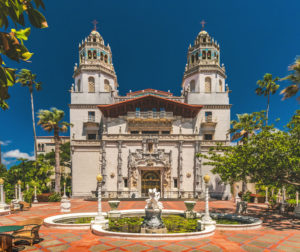Before Julia Morgan became an architect, only men practiced architecture. First she studied civil engineering at the University of California at Berkeley, graduating in 1894—the only woman in her class. At the time this was as close as one could get to an education in architecture there.
She then went to work as a draftsperson for Bernard Maybeck, a well-known California architect. He encouraged her to study at L’École Nationale Supérieure des Beaux-Arts, then the premier architecture school in the world.
She went to Paris and joined the atelier of Marcel Perouse de Monclos. In 1897 the French government began to allow women to study painting and sculpture at École des Beaux-Arts. They didn’t consider architecture for women.
They did not say anything about the Department of Architecture, either way, it not entering their heads that there might be women applicants.—Julia Morgan
Even so, she collected the necessary documentation and entered the design competitions, gaining admission in 1898. She graduated in 1902 and returned to California, where she worked with John Galen Howard on several buildings on the UC Berkeley campus. She became the first woman licensed to practice architecture in California in 1904.
El Campanil makes Julia Morgan’s career
One of her early projects was El Campanil, a bell tower on the campus of Mills College in Oakland, CA. Susan Mills, the president of the women’s college, wanted to further the career of a woman architect. Besides, the young Julia Morgan, eager for work, charged less than male architects.
Because of her engineering background, she was familiar with reinforced concrete—new technology at the time. El Campanil, one of the first reinforced concrete buildings west of the Mississippi, was completed in 1904.
For Californians like me, the great earthquake of 1906 was a defining event. My grandmother lived through it, and for the rest of her 92 years she was fearful whenever the earth shook even a little. Although most of the casualties were in San Francisco because of the fire, people as far away as Los Angeles, Oregon, and Nevada also felt the shaking.
Yet El Campanil, across the Bay from San Francisco, came through without damage. The architect whose tower survived when everything else crumbled to rubble was suddenly in demand. It even led to changes in California’s building code.
The old girls’ network

El Campanil wasn’t the only commission Morgan received through the influence of women. Women had been leading campaigners for everything from the abolition of slavery to temperance to votes for women. Naturally these activists sought to help women advance in other areas as well. As a result, many of Morgan’s commissions were for women’s organizations such as the YWCA, the Berkeley Women’s City Club, and the Ming Quong Home for Chinese Girls.
Phoebe Apperson Hearst became one of her supporters when they met in Paris. Shortly after Julia Morgan returned to California, Hearst hired her to remodel her estate in Pleasanton. Ten years later, she was instrumental in Morgan’s selection as the architect for the YWCA conference center in Asilomar.
Phoebe Hearst also introduced Morgan to her son, William Randolph Hearst. He hired her to design the Hearst Examiner Building in Los Angeles and eventually Hearst Castle in San Simeon, along with lesser Hearst estates.
As a comparison, the career of an African-American contemporary illustrates the difference the “old girls’ network” could make.
The legacy of Julia Morgan
In addition to Hearst Castle, Julia Morgan designed over 700 public and private buildings, mostly in California. Many of them are still in use. Growing up, I heard my mother’s stories about her father’s work for Julia Morgan. My grandfather and his brothers were among the European craftsmen who built her designs. In 1926 she even designed their church as a favor to them; 30 years later, my parents were married there.
When I studied civil engineering at UC Berkeley in the 1970s, it was still a male-dominated profession. Women comprised about 10% of my class. But unlike Julia Morgan, I had examples to follow, including hers. And her work was there on campus as a tangible reminder: some of my classes and labs were in the Hearst Mining Building, which she designed with John Galen Howard.
Even today, women architects can also face opposition and doubt. But they, too, can take heart from Julia Morgan’s example.
